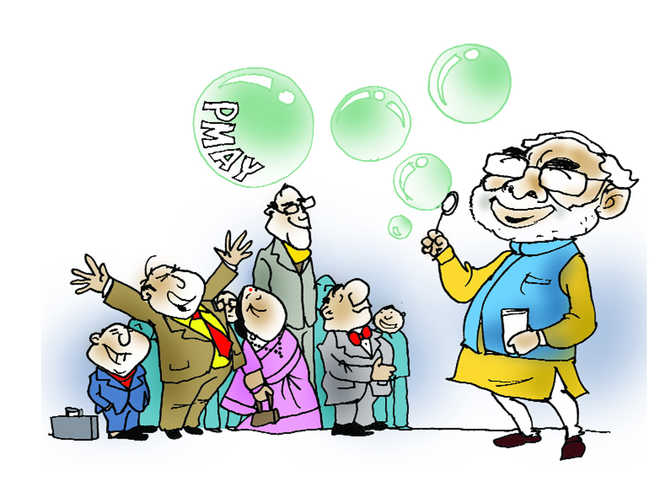
illustration: sandeep joshi
Ravi Sinha
With the government approving an increase in the carpet area of houses for the two middle-income group categories, under the Pradhan Mantri Awas Yojana – Urban, an impression is being created that the new norms would revitalise the real estate market and the standing housing inventory would be absorbed much sooner than expected.
A closer look at the top 10 cities and the price point clearly suggests that the move would hardly make an impact over the housing dynamics in these cities. Many of the Tier-II cities also defy economic rationale to support the industry-anticipated benefits.
Sanjeet Sharma is buying an 1100 sq feet (102.19 sq m) apartment in Mohali, Chandigarh. Will he now go for a 300 sq feet additional space to avail the benefits of new policy incentive? He just laughs it off and rather counter questions, “Do you know the cost of property in today’s market? Can you imagine my loan amount for this property?” Well, for a person like Sanjeet who is buying an apartment for Rs 90 lakh with a bank loan of Rs 70 lakh such announcements mean nothing.
Similarly, Shweta Mehrotra, a homebuyer in Noida that is among the most affordable property markets among the top 10 cities, is buying a 1200 sq feet (111.4 sq m) apartment for Rs 80 lakh. Her bank loan is Rs 60 lakh. Would she get tempted to buy a 1600 sq feet (148.6 sq m) apartment for Rs 1,10,000 and get benefitted with the new announcement? “I fail to understand why everyone is getting excited with a policy announcement that hardly touches a majority of homebuyers. I don’t think in the cities today anyone who falls in the income of up to Rs 12 lakh or Rs 18 lakh per annum would be in a position to think of buying a bigger house and take extra debt burden just to availof an EMI that will be a few hundred or a thousand rupees less,” says Shweta.
Most of the homebuyers across the country are of the opinion that instead of increasing the carpet area, that is mostly availed by the financially well-to-do buyers, had the government increased the income level or the subsidy level that would have encouraged more homebuyers.
Calculating reality
A back-of-the-envelope calculation reveals that most of the sub Rs 12 lakh p a income buyers anyway are not in a position to buy more than 1000 sq feet (92.2 sq m) houses. Similarly, a majority of the buyers with earning under Rs 18 lakh annually prefer to buy around 1200 sq feet (111.4 sq m) or at the max 1400 sq feet (130 sq m) houses.
In terms of the financial calculation, it is a globally accepted norm that any house that costs more than five years of gross income with the second simultaneous condition of not commanding more than 50 per cent of take-home salary is not affordable. With the given conventional wisdom of affordability, if a house costs Rs 80 lakh (considering 1000 sq feet or 92.2 sq m as the lowest base) for a buyer having Rs 12 lakh annual earning, it is a huge liability. This calculation clearly suggests that the size of the house cannot be exceeded by majority of the buyers with the PMAY reducing the EMI liability a few hundred rupees.
Playing the positivity card
The industry stakeholders are nevertheless trying their best to create a positive vibe around the scheme. Jaxay Shah, President, CREDAI-National, opines that Housing for All by 2022 has taken a huge leap forward by the increase in unit size of MIG Houses under Credit Linked Subsidy Scheme. The average middle class in smaller towns and cities would now be able to afford bigger and better quality homes than before. “On the supply side, private developers have improved incentives to increase scale and contribute to bringing about of New India. CREDAI compliments the government on relentlessly pursuing a progressive and inclusive agenda on housing,” says Shah.
Gagan Banga, VC & MD, Indiabulls Housing Finance echoes a similar sentiment when he says that the Cabinet’s decision is a massive positive for the macros of housing. The homebuyer now has a larger pool of prospective houses to choose from. The fence sitters specially, who were delaying their home purchase will now be given a further push.
“Builders, meanwhile, will not only enjoy the general uptick in the market that is ahead of us, but can also accelerate the sale of housing units which were earlier missing out on a sizeable portion of the Middle Income Group audience,” says Banga.
Counting on revival dream?
Even if one takes into account the stakeholders’ concern for the Tier-II cities benefitting from the scheme, property prices in most of the cities clearly indicate that the policy will not have any tangible result. Moreover, many of the Tier-II cities, like Patna, Lucknow, Jamshedpur, Bhubaneswar and many others for instance, have peaked the property price point to the extent of being more or less at Delhi-NCR level. Instead of offering larger carpet area for a small set of homebuyers, the policy should have been framed to offer larger financial assistance to even larger number of people.
— The writer is CEO, Track2Realty



























